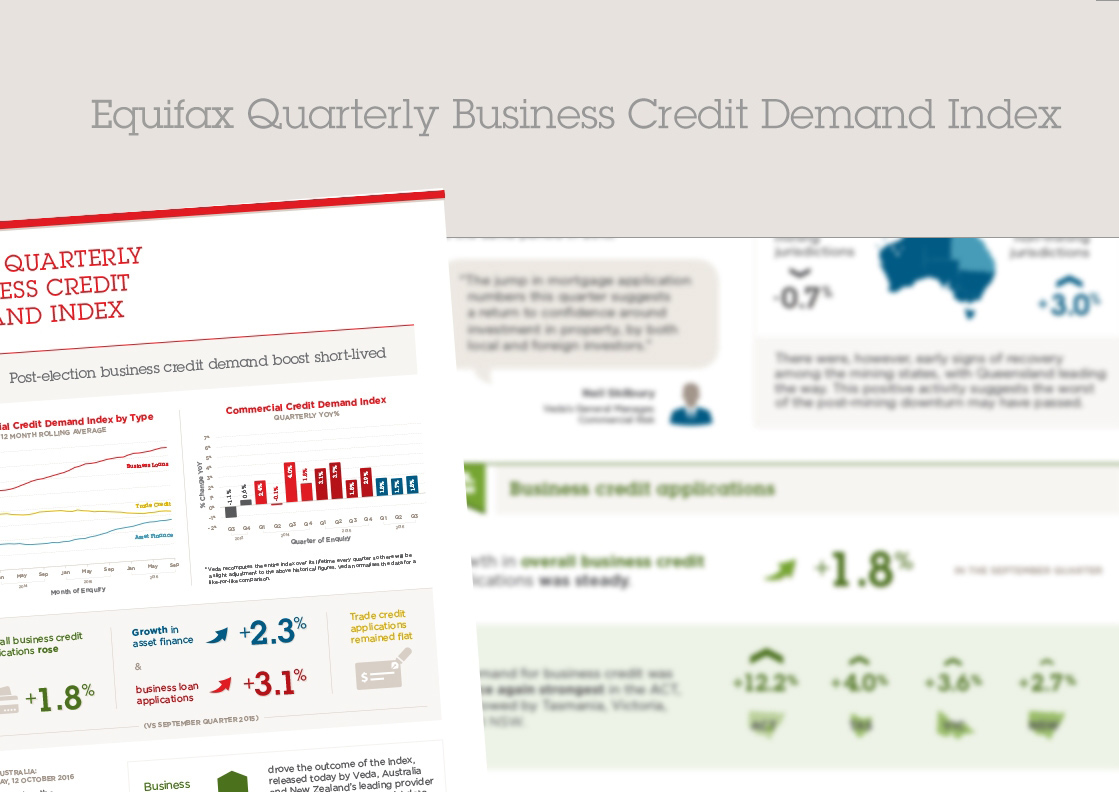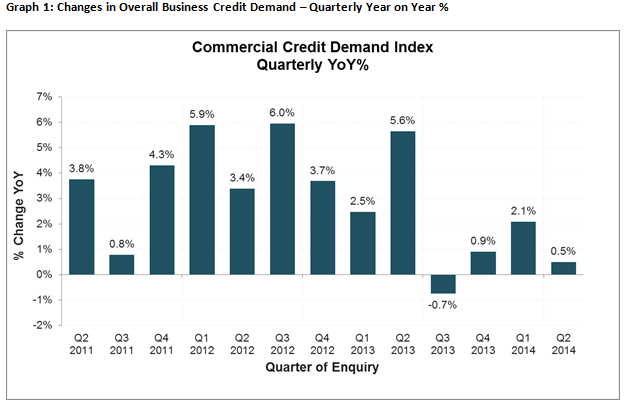Moderate Rise in Business Credit Demand, following spike in Q4 2013

Veda Quarterly Business Credit Demand Index: June 2014
- Overall business credit demand remained flat with an increase of 0.5% for the June quarter 2014 (vs. June quarter 2013)
- Decline in asset finance following peak in June quarter 2013
- Growth in business loan applications particularly across Australia’s Eastern seaboard states for the June quarter 2014
Sydney, Australia: 16 July 2014 – The Veda Quarterly Business Credit Demand Index, measuring applications for business loans, trade credit and asset finance expanded 0.5% in the June quarter 2014.
This increase is reflected in a drop in asset finance (-4.9%), offset by a small increase in trade credit applications (+0.3%) and a rise in business loans (+4.9%).
Veda’s General Manager Commercial Credit, Moses Samaha, said: “While overall conditions are flat, it’s important to put these results in the context of a boom in business credit demand in the June quarter 2013, where business loan demand grew almost 10% and asset finance by approximately 6%.
This time last year we saw the market for SME lending kick start which stimulated activity across the market materially. There was also acceleration in autofinance activity in anticipation of some tax treatments on leasing by the prior government.
“In light of last year’s peak, even though business credit demand only reported a moderate rise, the overall business outlook is still positive,” said Mr Samaha
Overall business credit applications declined across the mining states but grew in the non-mining states during the year to the June quarter. The mining states (WA, Queensland and NT) experienced an easing in business credit demand (-0.9%). Business credit applications in the non-mining states grew at an annual rate of 1.2% in the June quarter, deteriorating from an annual growth rate of 3.5% recorded in the March quarter 2014.
The best performing states were SA (+1.9%), NSW (+1.6%), Queensland (+1.1%), Victoria (+0.9%) and the ACT (+0.9%).
Falls were recorded in Tasmania (-5.8%), WA (-4.6%) and the NT (-1.5%)
Despite an easing nationally of business loan applications to +4.9%, stronger growth was seen in the eastern states including NSW (+5.2%), Victoria (+7.9%) and Queensland (+7.2%) as well as in SA (+7.7%), and the NT (+9.1%). A decline was recorded in WA (-5.9%), Tasmania (-4.6%) and the ACT (-4.7%).
Within business loans, the strength recorded earlier in the year for commercial mortgage applications eased (+3.3%), and applications for lending proposals (+13.6%) and overdrafts (+31.2%) lifted strongly.
Trade credit applications (+0.3%) softened in the June quarter. Falls in trade credit applications were reported in Victoria (-2.3%), followed by the NT (-2%).Tasmania and WA were flat (0%). Growth was seen in NSW (+0.5%), Queensland (+2%), SA (+3.5%), and the ACT (+6.2%).
“The new Federal Budget issued this June quarter may have stifled business confidence, impacting the level of SME activity in the market,” said Mr Samaha.
Trade credit applications increased during the year in the mining industry, but fell in the utilities, and construction industries.
Asset finance softened in the June quarter (-4.9%) after showing signs of recovery in the March quarter (-0.3%).
Within asset finance, hire purchase (-10.7%), leasing (-9.9%) and personal loan applications (-1.6%) contracted.
The mining states continued to show a decline in asset finance applications, with WA (-9.2%), Queensland (-7.1%), and the NT (-15.9%) all reporting applications fell further in the June quarter. Across the non-mining states, Tasmania (-16.3%), SA (-7.9%), and Victoria (-4.4%) are showing the sharpest falls, followed by NSW (-1.5%). Only the ACT (+2.8%) recorded positive growth for the quarter
The mining industry recorded a decline in asset finance applications in the past year. In contrast, applications rose in the transport and property services industries, while remaining broadly stable during the past year for the manufacturing and construction industries.
“The June quarter 2013 was especially strong last year, which has contributed to the decline in asset finance figures this quarter, amongst the pressure from the mining states’ investment in large projects easing,” Mr Samaha said.
The Veda Business Credit Demand Index has historically proven to be a lead indicator of how the overall economy is performing.
*Veda recomputes the entire index over its lifetime every quarter so there will be a slight adjustment to the above historical figures.

NOTE TO EDITORS
The Veda Quarterly Business Credit Demand Index measures the volume of credit applications that go through the Veda Commercial Bureau by credit providers such as financial institutions and major corporations in Australia. Based on this it is a good measure of intentions to acquire credit by businesses. This differs to other market measures published by the RBA/ABS, which measure new and cumulative dollar amounts that are actually approved by financial institutions.
DISCLAIMER
Purpose of Veda Indices releases: Veda Indices releases are intended as a contemporary contribution to data and commentary in relation to credit activity in the Australian economy. The information in this release does not constitute legal, accounting or other professional financial advice. The information may change and Veda does not guarantee its currency, accuracy or completeness, and you should rely on your own analysis and applications. Veda has relied on third party information in compiling the Indices and has not been able to independently verify the accuracy of that information. To the extent permitted by law, Veda specifically excludes all liability or responsibility for any loss or damage arising out of reliance on information in this release and the data in this report, including any consequential or indirect loss, loss of profit, loss of revenue or loss of business opportunity.
